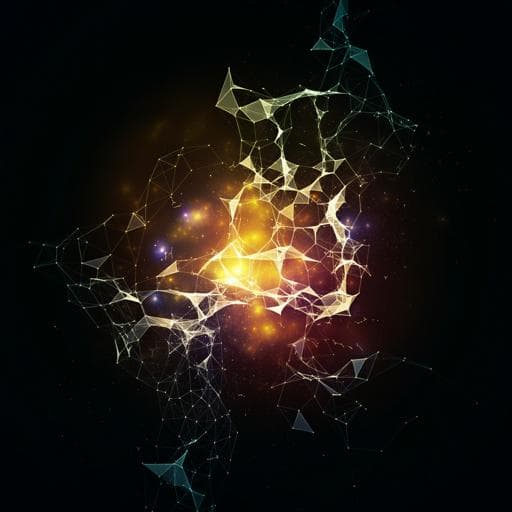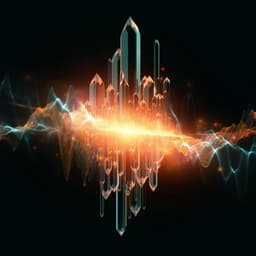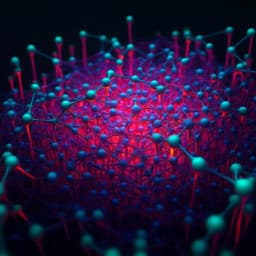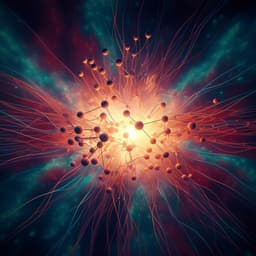
Physics
Resolution-enhanced X-ray fluorescence microscopy via deep residual networks
L. Wu, S. Bak, et al.
This groundbreaking research conducted by Longlong Wu, Seongmin Bak, Youngho Shin, Yong S. Chu, Shinjae Yoo, Ian K. Robinson, and Xiaojing Huang introduces a novel machine learning approach to significantly enhance the spatial resolution of X-ray fluorescence microscopy, transforming low-resolution images into high-quality super-resolved outputs. Discover how this innovative technique improves XRF tomography reconstructions for vital materials like LiNi0.6Mn0.2Co0.2O2 particles.
~3 min • Beginner • English
Introduction
Accurate nanoscale mapping of elemental distributions and morphology is crucial for understanding structure–property relations in functional materials. Multimodal imaging, especially combining ptychography and XRF, can provide concurrent structural (phase) and chemical maps. However, in scanning-probe XRF the spatial resolution is fundamentally limited by the incident X-ray probe size and scan scheme because the measured signal is a convolution of the probe intensity with the sample’s elemental distribution. This limits 2D XRF maps and propagates to 3D XRF tomography. Classical deblurring methods are not well-suited to this convolution under a scanning acquisition model. The study proposes a deep learning approach to decouple the beam profile from XRF signals and reconstruct super-resolved XRF images by leveraging simultaneously measured ptychographic probe information, addressing the resolution gap between XRF and ptychography.
Literature Review
The paper reviews that X-ray ptychography achieves high, often diffraction-limited, spatial resolution by phase retrieval of coherent diffraction data, and can simultaneously retrieve the incident probe profile. XRF provides element-specific maps but is resolution-limited by the probe size and scanning step. Prior computational deblurring methods are inadequate for the XRF scanning convolution. Deep learning has shown strong results in phase retrieval, denoising, phase unwrapping, and especially single-image super-resolution, typically under bicubic degradation models. However, ML has only nascent application to the XRF-specific deconvolution problem where the physics relates LR and HR images through a known probe and fly-scan integration. This gap motivates a tailored residual dense network to perform probe-aware super-resolution of XRF.
Methodology
Physical model: In fly-scan XRF, the measured yield Y(Z, r) is a convolution of the sample’s elemental distribution N(Z, r) with the moving probe intensity P(r−vt) integrated over detector dwell time, scaled by the XRF cross section σ(Z, λ). The probe profile P(r) is retrieved from ptychographic reconstructions of simultaneously acquired coherent diffraction patterns, enabling probe-informed deconvolution for XRF.
Experimental setup: Multimodal data were collected at the Hard X-ray Nanoprobe (HXN, 3-ID) beamline at NSLS-II with 9 keV incident energy. The beam was focused either by a Fresnel Zone Plate (FZP, 30 nm outermost zone) or by crossed Multilayer Laue Lenses (MLLs). On-the-fly raster scans simultaneously recorded energy-dispersive XRF with a Vortex detector and far-field diffraction with a pixel-array detector (Merlin). Ptychographic reconstructions used a GPU-accelerated iterative Difference Map algorithm (1000 iterations) with 5 illumination modes to account for fly-scan blur. Tomography reconstructions for both XRF and ptychography used TomoPy with 100 iterations of an ordered-subset penalized maximum likelihood algorithm.
RDN architecture: The proposed residual dense network (RDN) comprises feature extraction (two initial convolutions), multiple residual dense blocks (RDBs) with dense connections, local residual learning, batch normalization, and global feature fusion in LR space, followed by an up-sampling reconstruction using an Efficient Sub-Pixel Convolutional Network and three parallel RDBs in HR space. A final convolutional block (3×3 conv + LRLU + 1×1 conv + LiSHT activation) produces the HR XRF output. LR-space RDBs use 16 conv blocks (growth rate 64); HR-space has three parallel RDBs with two conv blocks each (growth rate 32).
Training data generation: To ensure diversity and generalization beyond specific materials, HR images were taken from the Caltech-256 Object Category dataset and degraded according to the XRF fly-scan physics: HR images were convolved with measured probe profiles (from ptychography) and integrated over continuous probe motion to synthesize LR images for each probe type (FZP, MLLs). For FZP: LR size 105×120 at 66.7 nm pixels; HR size 735×840 at 10 nm pixels; upscaling factor 7. For MLLs: LR size 120×120 at 50 nm pixels; HR size 1200×1200 at 5 nm pixels; upscaling factor 10. Probe images were 128×128 with pixel sizes 10 nm (FZP) and 5 nm (MLLs). Paired datasets: 17,640 (FZP) and 17,648 (MLLs). Splits: 95% train, 5% validation; separate test sets prepared. Batch size 2; early stopping to prevent overfitting (validation/test loss constrained).
Training details: Implemented in PyTorch with CUDA; Adam optimizer; initial learning rate 1e-3, halved every 15 epochs; 50 epochs typical (about 60 hours on two NVIDIA V100 GPUs, 256 GB RAM). Loss combined mean squared error and a modified Pearson correlation coefficient to balance intensity fidelity and structural similarity; final activation LiSHT. Performance monitored via PSNR and loss.
Tomography outputs: After applying the trained RDN to each XRF projection, 3D XRF reconstructions were computed. For FZP: LR volume 120×105×120 at 66.7 nm voxels; HR volume 840×735×840 at 10 nm voxels. For MLLs: LR volume 120×120×120 at 50 nm voxels; HR volume 1200×1200×1200 at 5 nm voxels.
Materials: Experimental validation used concentration-gradient NMC (LiNi0.6Mn0.2Co0.2O2) particles; synthesis via coprecipitation and calcination as previously reported.
Key Findings
- Simulations and test images: The RDN accurately reconstructs fine textures and edges from LR XRF inputs and outperforms bicubic interpolation at the same upscaling (7× for FZP; 10× for MLLs). Test loss decreased steadily, reaching approximately 8.4×10^-3 after 50 epochs.
- Experimental validation (NMC particles): Applying RDN to raw XRF projections from both FZP- and MLL-focused beams and reconstructing 3D volumes yielded markedly sharper elemental maps. The enhanced Ni XRF features closely matched structures in ptychographic phase-contrast tomography.
- Quantitative resolution gains: Estimated LR XRF resolutions were approximately 94.8 nm (FZP) and 57.4 nm (MLLs). After RDN enhancement, Fourier shell correlation indicated improved resolutions of about 22.0 nm (FZP) and 24.5 nm (MLLs).
- Chemical fidelity: Elemental percentage distributions (Ni, Mn, Co) were largely preserved before and after enhancement, with only slight redistributions, indicating the method maintains quantitative trends while increasing spatial detail.
- Generality across probes: Comparable improvements were achieved for two distinct nanoprobes (FZP and MLLs). Although MLLs had a smaller probe, the larger upscale factor required in that dataset likely limited further gains, evidencing the dependence on scan step/upscale ratio.
Discussion
The study demonstrates that a probe-informed deep residual dense network can effectively decouple the beam profile from XRF measurements acquired in a fly-scan, functioning as a learned deconvolution that respects the acquisition physics. By incorporating the ptychography-derived probe and learning from synthetic yet physically degraded data, the model bridges the resolution gap between XRF and ptychography. The close agreement of enhanced XRF features with ptychographic reconstructions supports the validity of the decoupling and reconstruction. The method generalizes across different focusing optics, but performance depends on parameters such as upscaling factor and scan overlap. The approach preserves elemental concentration trends, which is critical for materials analysis. Owing to ML parallelism, the pipeline offers speed advantages over traditional deconvolution, making it practical for high-throughput multimodal imaging.
Conclusion
An ML-based residual dense network was developed to enhance the spatial resolution of scanning XRF images by leveraging simultaneously measured ptychographic probe profiles. The approach improves both 2D XRF maps and 3D XRF tomography, achieving substantial resolution gains (to ~22–25 nm) from LR data constrained by probe size and scan step. It outperforms conventional interpolation and provides results consistent with ptychographic phase reconstructions. Demonstrations with two distinct nanoprobes (FZP and MLLs) and both simulated and experimental NMC datasets highlight generality and robustness. Future directions include expanding and diversifying training data, incorporating additional physics (e.g., self-absorption) in simulation, using transfer learning for rapid adaptation to new probes, and potentially including the incident probe as an explicit network input to further improve robustness and generalization.
Limitations
- Sensitivity to exact beam profile: Because the task is effectively a deconvolution, changes in the incident probe require retraining (though transfer learning can mitigate this).
- Dependence on scan parameters: Performance is impacted by the upscaling factor and effective overlap ratio between scan positions; larger overlaps generally enable better enhancement.
- Training data realism: The model was trained on simulated degradations of natural images; despite strong experimental performance, limitations in simulation fidelity (e.g., lack of self-absorption modeling) may constrain accuracy in some cases.
- Requirement of multimodal acquisition: Access to ptychography is needed to retrieve the probe profile for best performance.
- Minor quantitative shifts: Small redistributions in elemental percentages can occur, although overall concentration profiles are preserved.
Related Publications
Explore these studies to deepen your understanding of the subject.







